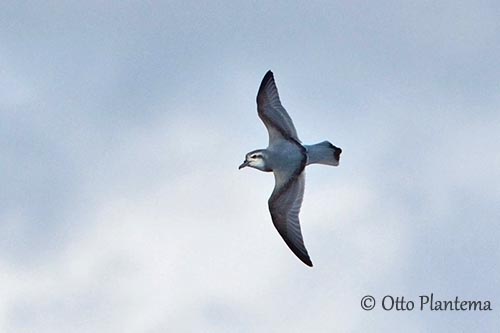
Salvin’s Prion
Pachyptila salvini
Procellariiformes Order – Porcellariidae Family
INTRODUCTION:
The name of this species pays tribute to the British ornithologist Osbert Salvin. All prions look very alike and occur in the Southern Ocean. All species, including both the prions of genus Pachyptila, and the Blue Petrel of genus Halobaena, have the typical dark M-shaped marking across the upperwing.
Prions have peculiar bill structure with broad, deep-based bill with pointed tip. The upper mandible is fringed with numerous lamellae, allowing the birds to filter the water in order to retain the small planktonic animals which are an important part of their diet.
Like numerous Procellariidae, the Salvin’s Prion is very feeble on land and only performs nocturnal visits to the nesting burrow.

DESCRIPTION OF THE BIRD:
Biometrics:
Length: 25-28 cm
Wingspan: 57-58 cm
Weight: 115-210 g (average 170 g)
The Salvin’s Prion adult has pale blue-grey upperparts with conspicuous blackish M-shaped marking on the upperwing. The three outermost primary flight-feathers are mostly blackish. The rearmost scapulars and tertials show blackish subterminal band with narrow greyish-white fringe. The uppertail is grey to bluish-grey with paler sides and broad black tip.
The underparts are white, including underwing and undertail, but there is a dark area on central undertail, and greyish tips to outer primaries. Thighs are greyish.
On the head, crown and forehead are dark slate-grey, whereas supercilium, sides of forehead to cheeks and lower face are white. We can see a dark grey stripe from eyes to most of ear-coverts. Neck sides are blue-grey.
The bill is greyish to grey-blue including the tip, but the culmen is black. The eyes are blackish. Legs are pale blue or grey and the webbed feet are greyer with pale pinkish tinge.
Male and female are similar.
The juvenile resembles adults. It has broader white tips to rear scapulars.
SUBSPECIES AND RANGE:
The Salvin’s Prion has two subspecies.
P.s. macgillivrayi (or MacGillivray’s Prion) occurs in S Indian Ocean and breeds on Amsterdam and St Paul Islands. This race has broader bill and slightly longer wings than nominate.
P.s. salvini (or Salvin’s Prion) is found in S Indian Ocean and Australasian seas. It breeds on Prince Edward and Marion Islands and Crozet Islands.
HABITAT:
The Salvin’s Prion nests in burrow excavated under tussock on islands, on highland plateaux or grassy slopes. Outside the breeding season, it can be found offshore, in upwelling areas.
CALLS AND SONGS: SOUNDS BY XENO-CANTO
The Salvin’s Prion rarely calls at sea, but it is more vocal at night at colonies. It gives harsh chattering calls and softer crooning. Male and female show marked differences in vocalizations.
BEHAVIOUR IN THE WILD:
The Salvin’s Prion feeds on crustaceans such as amphipods and euphausiids, and squid and fish of less than 7 centimetres long. It uses several methods to catch the preys, including surface-filtering with the comb-like lamellae, surface-seizing and surface-diving. It also performs shallow-plunging and pursuit-plunging.
But it also uses a peculiar technique called “hydroplaning”. The bird uses its feet to skim swiftly over the water surface, while the wings are outstretched and bill or/and head submerged.
They are gregarious at sea and usually occur in large flocks in the vicinity of their breeding islands. They fly alongside large vessels, but they are not attracted to boats.
During the breeding season, they breed in large colonies and visit their burrows at night. They may also stay inside the burrows during the day. As numerous birds are killed by skuas, they try to avoid predation by moving only at night.
Both mates perform mutual preening inside the burrow. Copulation probably follows this behaviour, sometimes accompanied by whistles or trills.
After the breeding season, the Salvin’s Prion disperses over the S Indian Ocean and occurs N to South Africa and Australia. Immature birds may wander E to New Zealand. Numerous birds are often beached in late winter on the W coast of the North Island.
The Salvin’s Prion is a good flier and flies with wingbeats interspersed with glides on stiff wings. The flight is very active and erratic, with much weaving and manoeuvring at great speed.
REPRODUCTION OF THIS SECIES:
The Salvin’s Prion returns to the colony in late September/October. The birds perform a pre-laying exodus during about ten days. The egg-laying takes place over three weeks in November/December.
The Salvin’s Prion excavates the burrow of 95-135 centimetres long. There is a lining of leaves and twigs. It may also nest in rock crevices, sometimes with other pairs. This species breeds in huge colonies of more than 1,000,000 birds.
The female lays a single white egg. Both parents incubate during 44-55 days in shifts of 5-7 days. The chick is fed by both adults and fledges about 54-65 days after hatching. It leaves the colony at night. This species produces a single brood per season.
PROTECTION / THREATS / STATUS:
The Salvin’s Prion is threatened by cats and rats in some breeding sites, but today, several breeding islands are free of introduced predators. The race Macgillivrayi is threatened by cats and rats, but also by deforestation.
The global population is estimated at 12,000,000 individuals.
The Salvin’s Prion is currently evaluated as Least Concern.
Fr: Prion de Salvin
Ang: Salvin’s Prion - Medium-billed Prion
All: KleinerEntensturmvogel
Esp: Pato-petrel de Salvin
Ita: Prione di Salvin
Nd: Salvin-prion
Sd: Salvins valfågel
Photographer:
Otto Plantema
Trips around the world
Text by Nicole Bouglouan
Sources:
HANDBOOK OF THE BIRDS OF THE WORLD vol 1 by Josep del Hoyo-Andrew Elliot-Jordi Sargatal - Lynx Edicions - ISBN: 8487334105
A Complete Guide to Antarctic Wildlife by Hadoram Shirihai and Illustrated by Brett Jarrett - Edited by Guy M. Kirwan - ALUL.A Press Oy, Finland - ISBN 9519894705
New Zealand birds and birding (Narena Olliver)
Wikipedia, the free encyclopaedia
New Zealand bird status between 2008 and 2012
Page family Procellariidae
Summary cards